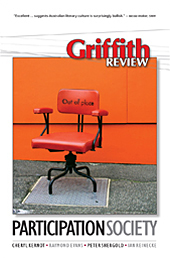Featured in

- Published 20090602
- ISBN: 9780733323959
- Extent: 264 pp
- Paperback (234 x 153mm)

Already a subscriber? Sign in here
If you are an educator or student wishing to access content for study purposes please contact us at griffithreview@griffith.edu.au
Share article
About the author

Mark Hopkinson
Mark Hopkinson is a former banker, now completing a Master of Studies in History at University College, Oxford.
More from this edition

Tribes of Berlin
MemoirTHE EARLY DAYS in a new city always feel similar to snorkeling, or taking hallucinogenics, or lucid dreaming – where nothing is fixed in...

A quiet revolution
EssayOnce in a rare while the fundamental architecture of a significant part of society shifts. Over the last two and one-half decades the organisation...

A woman’s place …
EssayTHE FEDERAL GOVERNMENT'S commitment to establish a new Indigenous national representative body provides Indigenous Australia with a unique opportunity to galvanise the potential of...